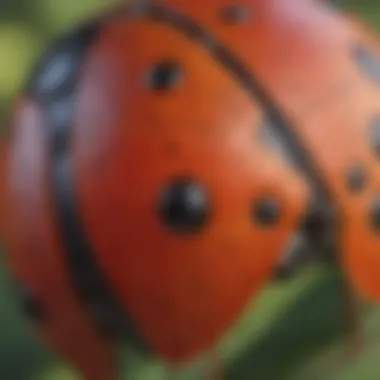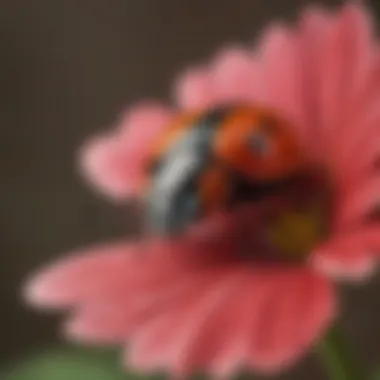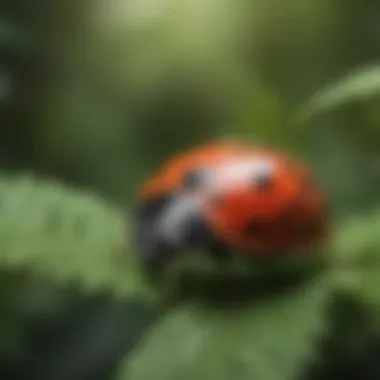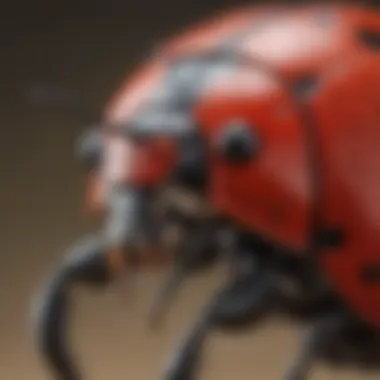Discovering the Enigmatic Ladybug: A Comprehensive Look into Nature's Tiny Marvel


Nature Topic Overview
Ladybugs, known for their distinctive red shells adorned with black spots, are Nature's tiny wonders that fascinate and intrigue both young and old minds. In this detailed exploration, we uncover the enigmatic charm of these diminutive creatures that play a vital role in maintaining ecological balance.
Fun Facts and Trivia
Discovering ladybugs can be like stumbling upon real-life jewels - did you know that these dainty insects can sport shades of yellow, orange, or even black, beyond the classic red? Engage curious young minds with interactive elements showcasing the diverse hues and patterns of these enchanting beetles.
Wildlife Explorations
Dive into the realm of ladybug varieties, where beyond the familiar red and black, lie a plethora of species, each with its unique markings and habits. Explore their natural habitats, from lush gardens to untamed meadows, and unravel the symbiotic relationships these tiny marvels forge with plants and other creatures.
Environmental Awareness
Ladybugs aren't just pretty polka-dots; they serve as vital pest controllers, munching on aphids that harm plants - a boon for organic farming. Instill in young nature enthusiasts the significance of conservation and sustainability, empowering them with simple tips to contribute to preserving these beneficial insects' habitats.
DIY Nature Activities
Encourage budding scientists with hands-on ladybug-themed marvels! From creating miniature ladybug habitats to observing their behaviors up close, pave the way for young minds to appreciate nature's intricacies through outdoor explorations and engaging projects. Spark their curiosity and creativity with step-by-step guides that bring the magical world of ladybugs to life.
Introduction
Ladybugs, also known as ladybirds in some regions, are intriguing creatures that have fascinated both children and adults through their charming appearance and mysterious behavior. In this comprehensive exploration of ladybugs, we delve deep into the captivating world of these tiny wonders to uncover their unique traits, behavior, and significant role in maintaining nature's delicate balance. By shedding light on the enigmatic nature of the ladybug, readers will gain a profound understanding of these minute yet essential creatures that play a crucial part in the ecosystem.
Origins and Name
Historical Significance
Ladybugs hold a rich historical significance that dates back centuries, symbolizing various beliefs and superstitions across different cultures. Their presence in folklore and mythology has imbued them with a mystical aura, enhancing their enigmatic appeal. Exploring the historical facets of ladybugs provides insights into the deep-rooted connections between humans and nature, making them a subject of intrigue and admiration.
Etymology of the Name


The etymology of the name 'ladybug' carries linguistic relevance, reflecting the diverse cultural interpretations surrounding these vibrant insects. Understanding the origin of the name sheds light on the symbolic significance attached to ladybugs in different societies, showcasing their symbolic importance beyond their physical attributes. Unraveling the layers of meaning embedded in their name adds a profound dimension to the study of these fascinating creatures.
Physical Characteristics
Distinctive Features
Ladybugs are renowned for their distinctive features, including vibrant coloration and symmetrical patterns that serve as natural defense mechanisms. Their compact size and rounded shape contribute to their visual appeal, making them easily recognizable in diverse habitats. Exploring the distinctive features of ladybugs unveils the intricate details of their anatomy, highlighting evolutionary adaptations that have ensured their survival in ever-changing environments.
Variety in Species
The sheer diversity of ladybug species showcases the adaptability and resilience of these remarkable insects across different geographical regions. From the classic red with black spots to rare variations in color and pattern, each species offers a unique glimpse into the evolutionary pathways traversed by ladybugs. Investigating the variety in species provides a glimpse into the intricate biodiversity of these tiny wonders, underscoring their ecological significance and evolutionary success.
Behavior and Habitat
When discussing the behavior and habitat of ladybugs in this article, it is crucial to highlight the intricate relationship between these aspects and the overall ecosystem. Ladybugs play a pivotal role in maintaining ecological balance through their feeding habits and choice of habitats. Their behavior, such as foraging for food and selecting specific plants to interact with, directly impacts the surrounding environment. By understanding their behavior and habitat preferences, we can appreciate the significance of these tiny creatures in nature's intricate web of life.
Feeding Habits
Dietary Preferences
Ladybugs showcase a fascinating array of dietary preferences that contribute to their survival and reproductive success. Their primary diet consists of aphids, mites, and other small insects, positioning them as valuable predators in controlling pest populations. This dietary choice not only sustains the ladybug population but also benefits ecosystems by regulating pest levels naturally. The unique feature of targeting specific insect prey showcases the ladybug's adaptability and efficiency in pest management, a trait highly beneficial in agricultural and natural settings.
Foraging Behavior
Ladybugs exhibit distinct foraging behavior characterized by their methodical approach to finding food sources. Their keen ability to locate and consume prey efficiently makes them efficient predators in various habitats. The behavior of actively searching for prey demonstrates the ladybug's role as a biocontrol agent, contributing to pest suppression. The benefit of this behavior lies in its targeted nature, allowing ladybugs to sustainably manage pest populations without causing harm to beneficial insects.
Lifecycle Stages
Egg Phase
The egg phase of a ladybug's lifecycle signifies the beginning of their development and growth. Ladybug eggs are typically laid on plants abundant in aphids, ensuring an accessible food source for the emerging larvae. This strategic placement increases the survival rate of the offspring, showcasing the evolutionary advantage of this reproductive strategy. The unique feature of relying on specific plants for egg-laying highlights the specialized nature of ladybug reproduction, setting the stage for future generations.


Larval Stage
During the larval stage, ladybugs undergo significant physical and behavioral transformations to prepare for adulthood. The larvae exhibit voracious appetites, consuming various prey to fuel their rapid growth. This stage is crucial for building strength and resilience before transitioning into the pupal phase. The key characteristic of the larval stage lies in its role as a critical period for development, shaping the ladybug's abilities as an effective predator.
Pupal Transformation
The pupal transformation stage marks a profound metamorphosis in the ladybug's life cycle, as it undergoes structural changes to transition into its adult form. Within the protective casing of the pupa, intricate processes occur, leading to the emergence of a fully formed adult ladybug. This transformational phase symbolizes growth, renewal, and adaptation, showcasing the resilience and adaptability of these remarkable insects.
Adult Ladybug
The adult ladybug represents the pinnacle of development in their lifecycle, embodying the culmination of their metamorphosis and growth. As fully formed insects, adult ladybugs exhibit the distinctive colors and patterns that characterize their species. Their ability to fly and search for mates further solidifies their role in maintaining population growth and genetic diversity. The adult stage of a ladybug's life is essential for reproduction, dispersal, and contributing to pest control efforts.
Preferred Habitats
Natural Environment
Ladybugs thrive in diverse natural environments, ranging from meadows and forests to agricultural fields and urban gardens. Their adaptability to various ecosystems highlights their versatility as beneficial insects. By choosing habitats rich in prey insects and suitable plants for oviposition, ladybugs ensure their survival and reproductive success. The unique feature of thriving in different natural settings underscores their importance in maintaining ecological balance.
Interactions with Plants
Ladybugs interact closely with plants, utilizing them for food, shelter, and reproduction. These interactions play a significant role in the lifecycle of ladybugs, as certain plant species provide essential resources for their development. Ladybugs select specific plants based on their attractiveness to prey insects, aiding in efficient foraging and reproductive strategies. The benefit of these interactions lies in the mutualistic relationship between ladybugs and plants, fostering biodiversity and sustainability in various ecosystems.
Ecological Significance
Ladybugs, also known as ladybirds or lady beetles, play a crucial role in the ecosystem due to their predatory behavior towards harmful insects. These charming insects are voracious predators of aphids, mites, and other plant-damaging pests, making them invaluable assets for natural pest control. By preying on these pests, ladybugs help maintain a healthy balance in the ecosystem, reducing the need for harmful pesticides.
Their presence not only benefits plants and crops but also minimizes the environmental impact of chemical insecticides. Furthermore, ladybugs serve as bioindicators, reflecting the overall health of ecosystems. Studying their population dynamics can provide valuable insights into environmental changes and ecosystem stability. In essence, the ecological significance of ladybugs lies in their role as efficient pest controllers and vital indicators of environmental health.
Predatory Behavior
Role in Pest Control


Ladybugs are renowned for their effectiveness in natural pest management. Their consumption of pest insects like aphids helps protect agricultural crops, gardens, and ornamental plants from damage. This biological pest control method is eco-friendly and sustainable, with ladybugs targeting harmful insects without causing harm to other beneficial organisms. Their ability to quickly reproduce and thrive in diverse habitats enhances their impact on pest populations, contributing to the overall health of ecosystems.
Impact on Agriculture
The impact of ladybugs on agriculture is substantial, with farmers and gardeners appreciating their pest control services. By reducing the need for chemical pesticides, ladybugs promote environmentally friendly farming practices. This benefits both agricultural productivity and biodiversity, as pesticides can harm non-target organisms and disrupt ecosystem balance. Additionally, the presence of ladybugs in agricultural landscapes can serve as a natural indicator of ecosystem health, reflecting the success of integrated pest management strategies.
Symbiotic Relationships
Association with Plants
Ladybugs exhibit symbiotic relationships with various plant species, benefiting both the insects and the plants. These beneficial interactions often involve protection from herbivores or pathogens, with ladybugs feeding on pests that threaten plant health. In return, some plants provide shelter, food, or nectar sources for ladybugs, enhancing their survival and reproductive success.
Mutualistic Partnerships
Ladybugs engage in mutualistic partnerships with certain organisms, fostering mutually beneficial relationships. For example, some species of ants form symbiotic associations with ladybugs, offering protection in exchange for honeydew secretions produced by the insects. These partnerships demonstrate the interconnectedness of species in ecological communities, highlighting the intricate web of relationships that contribute to ecosystem resilience and stability.
Cultural and Symbolic Importance
In this section, we navigate the intricate realm of cultural and symbolic significance associated with the enigmatic ladybug. These creatures hold a profound place in folklore, inspiring awe and wonder in various cultures. Discovering the roots of beliefs and superstitions surrounding ladybugs enriches our understanding of their symbolic importance. Exploring how these tiny wonders have been woven into myths and legends adds a layer of mystery to their already fascinating existence.
Folklore and Legends
Mythological Beliefs
Delving into the tapestry of mythological beliefs woven around ladybugs reveals the timeless appeal these insects hold. The enduring belief in ladybugs as messengers of good luck resonates across cultures, making them symbols of positivity and protection. Their association with fortune and blessings shapes narratives, making ladybugs a cherished emblem in folklore. Despite variations in stories, the essence of ladybugs as harbingers of hope remains a common thread connecting diverse traditions.
Superstitions and Omens
Exploring the realm of superstitions and omens revolving around ladybugs unravels intriguing aspects of cultural beliefs. From superstitions heralding prosperity upon a ladybug landing to interpretations of their spots foretelling future events, these insects are laden with symbolic significance. Observing the superstitions linked to ladybugs sheds light on how they have been perceived throughout history, offering insights into the human fascination with the mystical and the unexplained.
Symbolism in Different Cultures
Representations in Art
The representation of ladybugs in art serves as a testament to their enduring symbolism and aesthetic appeal. Artists have captured the essence of ladybugs through various mediums, portraying them as symbols of joy, love, and fortune. Their distinct coloration and gentle presence make ladybugs popular subjects in artistic depictions, symbolizing harmony and luck. Exploring these artistic representations allows us to appreciate the timeless allure of ladybugs as subjects of creative inspiration.
Meanings Across the World
Unraveling the meanings associated with ladybugs across different cultures unveils a tapestry of diverse interpretations. While some cultures view ladybugs as bearers of good fortune and prosperity, others attribute spiritual significance to their presence. Understanding the varied meanings assigned to ladybugs broadens our perception of these insects as carriers of positive energy and blessings. Exploring the cross-cultural significance of ladybugs showcases the universal appeal and enduring charm these tiny creatures hold.







